Water Budget of Urban Turf Field and Optimal Irrigation Schedule Simulation in an Ecotone between Semi-Humid and Semi-Arid Regions, Northern China
Abstract
1. Introduction
2. Materials and Methods
2.1. Experimental Site
2.2. Information on Turf Management
2.3. Data Collection
2.3.1. Meteorological Data
2.3.2. Soil Data
2.3.3. Experimental Management
2.4. RZWQM2 Description
2.5. Model Performance Criteria and Calculations
2.6. Simulation Schedule Design
2.7. Construction of Irrigation Evaluation Index System
2.7.1. Evaluation Indicators and Methods
2.7.2. Determining the Weights of Evaluation Indicators
2.7.3. Evaluation of Entropy Weight-TOPSIS Model
- (1)
- Entropy method to determine the weight
- (2)
- Construction of evaluation matrix
- (3)
- TOPSIS determines the distance of the index to the positive and negative ideals
- (4)
- Calculation of the comprehensive evaluation index
3. Results and Discussion
3.1. Water Balance Analysis
3.1.1. Volumetric Water Content Variation in Different Soil Profiles
3.1.2. Variation in Evapotranspiration under at Varying Time Scales
3.1.3. Seepage Variation
3.2. Model Calibration and Validation Results
Simulation of Volumetric Water Content
3.3. Response Simulation of Different Irrigation Schedules
3.3.1. Soil Water Storage
3.3.2. Total Evapotranspiration
3.3.3. Cumulative Seepage
3.4. Entropy Weight-TOPSIS Method to Evaluate Optimal Irrigation Schedule
3.5. Optimizing the Irrigation Scheduling
4. Conclusions
Author Contributions
Funding
Data Availability Statement
Conflicts of Interest
References
- Ding, Z.; Chen, Y.; Hu, C. Water Shortage and Water Shortage Types in China. Spec. Zone Econ. 2018, 9, 47–50. [Google Scholar]
- NBSC (National Bureau of Statistics of China). China Statistical Yearbook 2017; National Bureau of Statistics Press: Beijing, China, 2017.
- Pei, H.; Zhang, H.; Li, Y.; Liu, M.; Xiao, Y.; Wang, F. Characteristics and drivers of turf evapotranspiration in Northern China: A case study of turf (Poa Pratensis) in Zhangjiakou City, Hebei Province. Water Sav. Irrig. 2021, 11, 1–6. [Google Scholar]
- Lu, C.; Deng, O.; Li, Y. A Study on Spatial Variation of Water Security Risks for the Zhangjiakou Region. J. Resour. Ecol. 2021, 12, 91–98. [Google Scholar]
- Xuan, W.; Quan, C.; Shu, L. An optimal water allocation model based on water resources security assessment and its application in Zhangjiakou Region, northern China. Resour. Conserv. Recycl. 2012, 69, 57–65. [Google Scholar] [CrossRef]
- Sevostianova, E.; Leinauer, B. Subsurface-applied tailored water: Combining nutrient benefits with efficient turfgrass irrigation. Crop Sci. 2014, 54, 1926–1938. [Google Scholar] [CrossRef]
- Grabow, G.; Ghali, I.; Huffman, R.; Miller, G.; Bowman, D.; Vasanth, A. Water application efficiency and adequacy of ET-based and soil moisture–based irrigation controllers for turfgrass irrigation. J. Irrig. Drain. Eng. 2013, 139, 113–123. [Google Scholar] [CrossRef]
- Fillo, N.K.; Bhaskar, A.S.; Jefferson, A.J. Lawn Irrigation Contributions to Semi-Arid Urban Baseflow Based on Water-Stable Isotopes. Water Resour. Res. 2021, 57, e2020WR028777. [Google Scholar] [CrossRef]
- Jeong, H.; Pittelkow, C.M.; Bhattarai, R. Simulated responses of tile-drained agricultural systems to recent changes in ambient atmospheric gradients. Agric. Syst. 2019, 168, 48–55. [Google Scholar] [CrossRef]
- Ma, L.; Ahuja, L.; Nolan, B.; Malone, R.; Trout, T.; Qi, Z. Root zone water quality model (RZWQM2): Model use, calibration, and validation. Trans. ASABE 2012, 55, 1425–1446. [Google Scholar] [CrossRef]
- El-Sadek, A.N.; Salem, E.M.M. Simulation of wheat yield using the RZWQM as affected by supplemental irrigation in the North Western Coast of Egypt. Eur. J. Agron. 2016, 38, 279–292. [Google Scholar]
- Zhang, H.; Ma, L.; Douglas-Mankin, K.R.; Han, M.; Trout, T.J. Modeling maize production under growth stage-based deficit irrigation management with RZWQM2. Agric. Water Manag. 2021, 248, 106767. [Google Scholar] [CrossRef]
- Kuang, N.; Ma, Y.; Hong, S.; Jiao, F.; Liu, C.; Li, Q.; Han, H. Simulation of soil moisture dynamics, evapotranspiration, and water drainage of summer maize in response to different depths of subsoiling with RZWQM2. Agric. Water Manag. 2021, 249, 106794. [Google Scholar] [CrossRef]
- Zhou, S.; Hu, X.; Ran, H.; Wang, W.; Hansen, N.; Cui, N. Optimization of irrigation and nitrogen fertilizer management for spring maize in northwestern China using RZWQM2. Agric. Water Manag. 2020, 240, 106276. [Google Scholar] [CrossRef]
- Shrestha, S.; Manandhar, B. Evaluation of the Root Zone Water Quality Model (RZWQM) using field-measured data from the tropical zone, Thailand. Water Air Soil Pollut. 2014, 225, 1–14. [Google Scholar] [CrossRef]
- Jeong, H.; Bhattarai, R. Exploring the effects of nitrogen fertilization management alternatives on nitrate loss and crop yields in tile-drained fields in Illinois. J. Environ. Qual 2018, 213, 341–352. [Google Scholar] [CrossRef]
- Sun, M.; Huo, Z.; Zheng, Y.; Dai, X.; Feng, S.; Mao, X. Quantifying long-term responses of crop yield and nitrate leaching in an intensive farmland using agro-eco-environmental model. Sci. Total Environ. 2018, 613, 1003–1012. [Google Scholar] [CrossRef]
- Li, Z.; Sun, Z. Optimized single irrigation can achieve high corn yield and water use efficiency in the Corn Belt of Northeast China. Eur. J. Agron. 2016, 75, 12–24. [Google Scholar] [CrossRef]
- Zhang, K.; Shao, G.; Wang, Z.; Cui, J.; Lu, J.; Gao, Y. Modeling the impacts of groundwater depth and biochar addition on tomato production under climate change using RZWQM2. Sci. Hortic. 2022, 302, 111147. [Google Scholar] [CrossRef]
- Hong, S.; Jiao, F.; Kuang, N.; Liu, C.; Ma, Y.; Li, Q. Simulating the effects of irrigation and tillage on soil water, evapotranspiration, and yield of winter wheat with RZWQM2. Soil Tillage Res. 2021, 214, 105170. [Google Scholar] [CrossRef]
- Chen, X.; Qi, Z.; Gui, D.; Gu, Z.; Ma, L.; Zeng, F.; Li, L. Simulating impacts of climate change on cotton yield and water requirement using RZWQM2. Agric. Water Manag. 2019, 222, 231–241. [Google Scholar] [CrossRef]
- Sadhukhan, D.; Qi, Z.; Zhang, T.; Tan, C.S.; Ma, L.; Andales, A.A. Development and evaluationof a phosphorus (P) module in RZWQM2 for phosphorus management in agricultural fields. Environ. Model. Softw. 2019, 113, 48–58. [Google Scholar] [CrossRef]
- Allen, R.G.; Pereira, L.S.; Raes, D.; Smith, M. Crop Evapotranspiration Guidelines for Computing Crop Water Requirements-FAO Irrigation and Drainage Paper 56; FAO: Rome, Italy, 1998; Volume 300, p. D05109. [Google Scholar]
- Qin, A.; Ning, D.; Liu, Z.; Li, S.; Zhao, B.; Duan, A. Determining threshold values for a crop water stress index-based center pivot irrigation with optimum grain yield. Agriculture 2021, 1, 958. [Google Scholar] [CrossRef]
- Landa, F.M.; Fausey, N.R.; Nokes, S.E.; Hanson, J.D. Plant production model evaluation for the root zone water quality model (RZWQM 3.2) in Ohio. Agron. J. 1999, 91, 220–227. [Google Scholar] [CrossRef]
- Ahuja, L.; Rojas, K.W.; Hanson, J.D. Root Zone Water Quality Model: Modelling Management Effects on Water Quality and Crop Production; Water Resources Publication: Littleton, CO, USA, 2000; pp. 13–50. [Google Scholar]
- Ma, L.; Ahuja, L.R.; Bruulsema, T. Quantifying and Understanding Plant Nitrogen Uptake for Systems Modeling; CRC Press: Boca Raton, FL, USA, 2008. [Google Scholar]
- Ma, L.; Hoogenboom, G.; Ahuja, L.R.; Ascough, J.C.; Saseendran, S.A. Evaluation of the RZWQM-CERES-Maize hybrid model for maize production. Agric. Syst. 2006, 87, 274–295. [Google Scholar] [CrossRef]
- Teng, J.; Yasufuku, N.; Liu, Q.; Liu, S. Analytical solution for soil water redistribution during evaporation process. Water Sci. Technol. 2013, 68, 2545–2551. [Google Scholar] [CrossRef]
- Fang, Q.; Yu, Q.; Wang, J. Simulating soil water dynamics and its effects on crop yield using RZWQM- CERES in the North China plain. Acta Agron. Sin. 2009, 35, 1122–1130. [Google Scholar] [CrossRef]
- Gu, Z.; Qi, Z.; Ma, L.; Gui, D.; Xu, J.; Fang, Q.; Feng, G. Development of an irrigation scheduling software based on model predicted crop water stress. Comput. Electron. Agric. 2017, 143, 208–221. [Google Scholar] [CrossRef]
- Legates, D.R.; McCabe, G.J. Evaluating the use of “goodness-of-fit” measures in hydrologic and hydroclimate model validation. Water Resour Res. 1999, 35, 233–241. [Google Scholar] [CrossRef]
- Qi, Z.; Ma, L.; Helmers, M.J.; Ahuja, L.R.; Malone, R.W. Simulating nitrate-nitrogen concentration from a subsurface drainage system in response to nitrogen application rates using RZWQM2. J. Environ. Qual. 2012, 41, 289–295. [Google Scholar] [CrossRef]
- Jiang, Y.; Zhang, L.; Zhang, B.; He, C.; Jin, X.; Bai, X. Modeling irrigation management for water conservation by DSSAT-maize model in arid northwestern China. Agric. Water Manag. 2016, 177, 37–45. [Google Scholar] [CrossRef]
- Ding, J.; Hu, W.; Wu, J.; Yang, Y.; Feng, H. Simulating the effects of conventional versus conservation tillage on soil water, nitrogen dynamics, and yield of winter wheat with RZWQM2. Agric. Water Manag. 2020, 230, 105956. [Google Scholar] [CrossRef]
- Malone, R.W.; Nolan, B.T.; Ma, L.; Kanwar, R.S.; Pederson, C.; Heilman, P. Effects of tillage and application rate on atrazine transport to subsurface drainage: Evaluation of RZWQM using a six-year field study. Agric. Water Manag. 2014, 132, 10–22. [Google Scholar] [CrossRef]
- Liu, C.; Jiang, W.; Wu, Y.; Liu, Y.; Liang, L. Estimation of regional farmland irrigation water requirements and water balance in Northeast China. Environ. Sci. Pollut. Res. 2022, 29, 71840–71856. [Google Scholar] [CrossRef]
- Liu, C.; Zhou, L.; Jia, J.; Wang, L.; Si, J.; Li, X.; Li, F. Maize yield and water balance is affected by nitrogen application in a film-mulching ridge–furrow system in a semiarid region of China. Eur. J. Agron. 2014, 52, 103–111. [Google Scholar] [CrossRef]
- Zhou, H.; Zhao, W. Modeling soil water balance and irrigation strategies in a flood-irrigated wheat-maize rotation system. A case in dry climate China. Agric. Water Manag. 2019, 221, 286–302. [Google Scholar] [CrossRef]
- Guo, C.; Zhang, Y.; Liu, Z.; Li, N. A Coupling Mechanism and the Measurement of Science and Technology Innovation and Rural Revitalization Systems. Sustainability 2022, 14, 10343. [Google Scholar] [CrossRef]
- Kim, A.R. A study on competitiveness analysis of ports in Korea and China by entropy weight TOPSIS. Asian J. Shipp. Logist. 2016, 32, 187–194. [Google Scholar] [CrossRef]
- Sun, Q.; Han, J.; Liu, S.; Zhou, L. The results of this study were similar to the results of soil moisture content changes in Sun Qiang’s Beijing turf. Acta Ecol. Sin. 2005, 25, 1306–1311. [Google Scholar]
- Braun, R.C.; Bremer, D.J.; Ebdon, J.S.; Fry, J.D.; Patton, A.J. Review of cool-season turfgrass water use and requirements: I. Evapotranspiration and responses to deficit irrigation. Crop Sci. 2022, 62, 1661–1684. [Google Scholar] [CrossRef]
- Du, K.; Qiao, Y.; Zhang, Q.; Li, F.; Li, Q.; Liu, S.; Tian, C. Modeling soil water content and crop-growth metrics in a wheat field in the North China plain using RZWQM2. Agronomy 2021, 11, 1245. [Google Scholar] [CrossRef]
- Fang, Q.; Ma, L.; Yu, Q.; Hu, C.; Li, X.; Malone, R.; Ahuja, L. Quantifying climate and management effects on regional crop yield and nitrogen leaching in the North China Plain. J. Environ. Qual. 2013, 42, 1466–1479. [Google Scholar] [CrossRef] [PubMed]
- Ma, L.; Ahuja, L.R.; Saseendran, S.A.; Malone, R.W.; Green, T.R.; Nolan, B.T.; Bartling, P.N.S.; Flerchinger, G.N.; Boote, K.J.; Hoogenboom, G. A protocol for parameterization and calibration of RZWQM2 in field research. In Methods of Introducing System Models into Agricultural Research; American Society of Agronomy, Crop Science Society of America, and Soil Science Society of America: Washington, DC, USA, 2015; pp. 1–64. [Google Scholar]

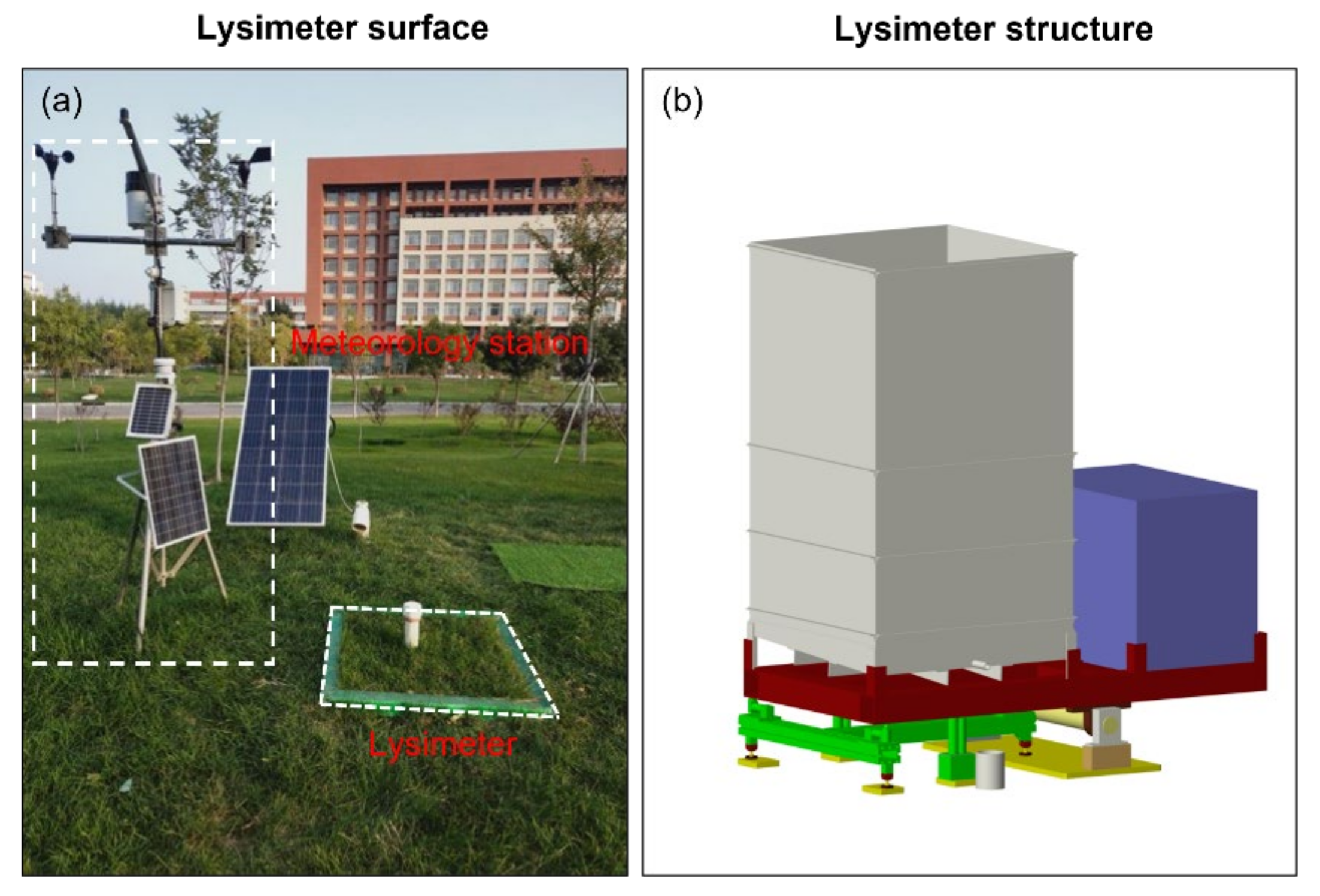
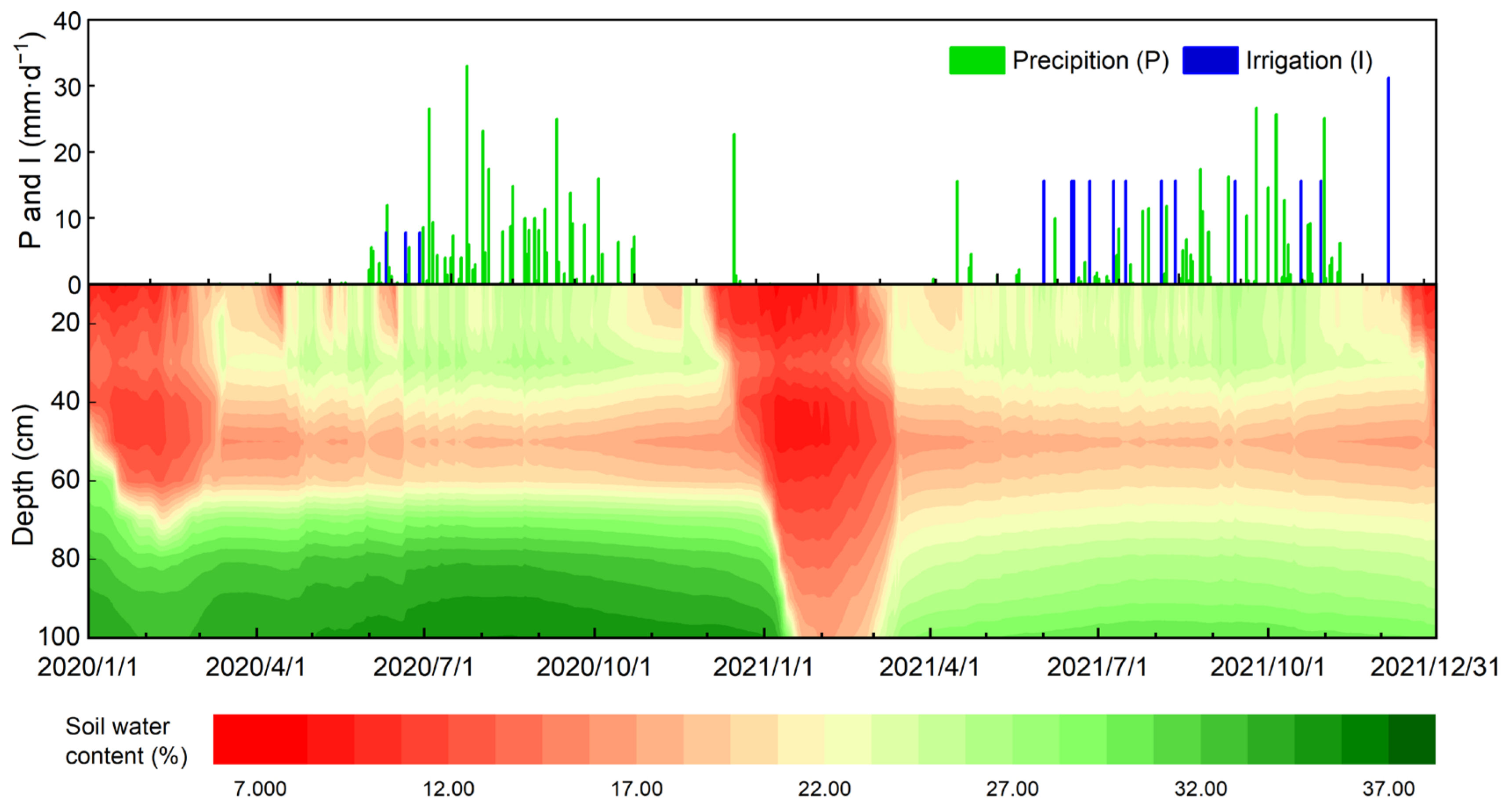
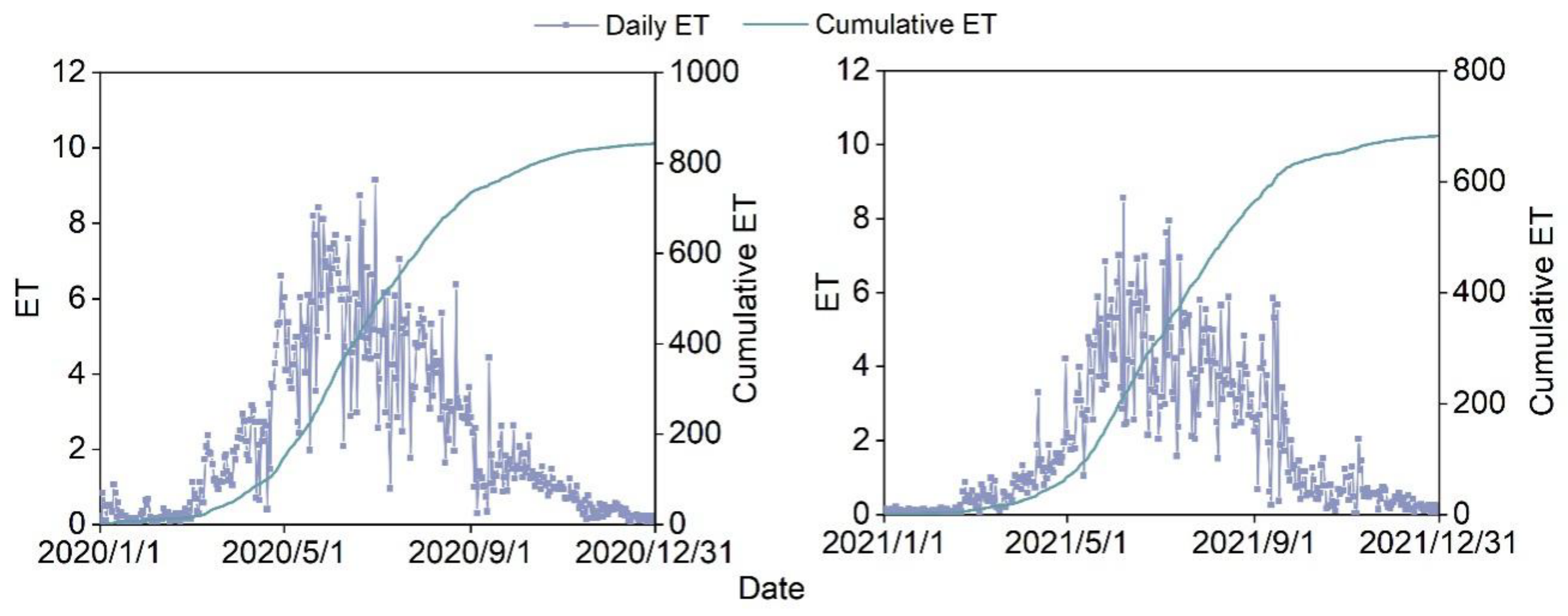
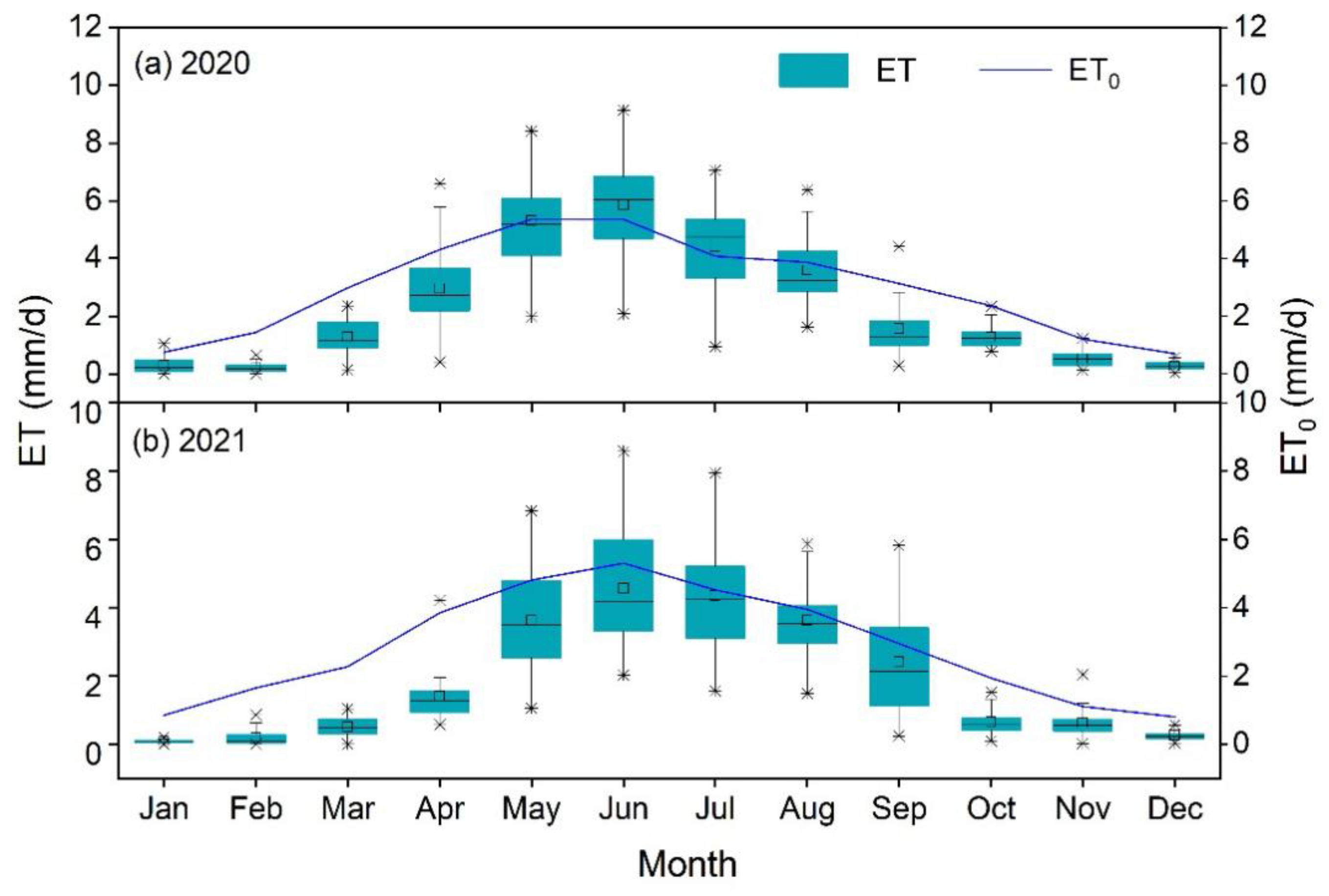
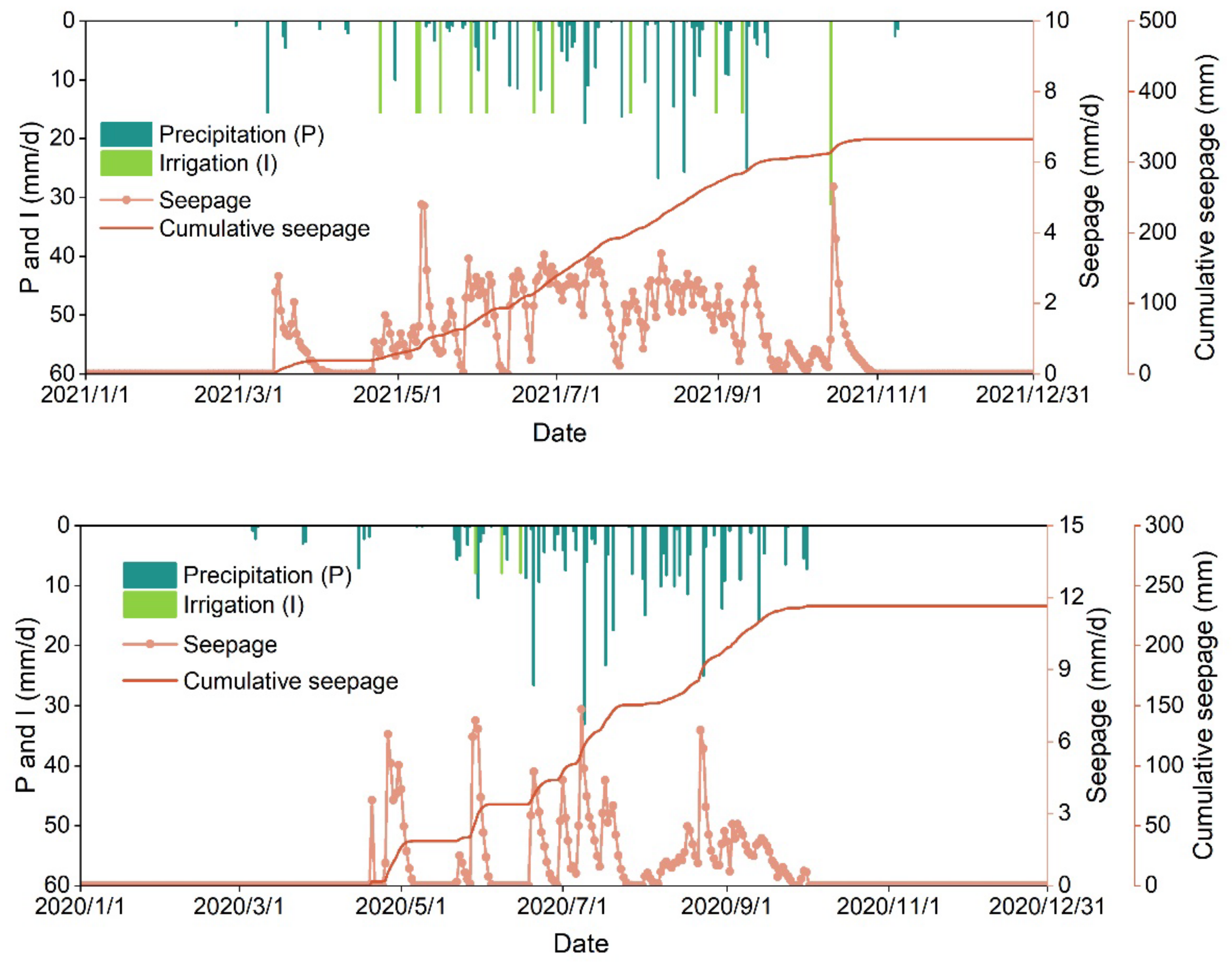
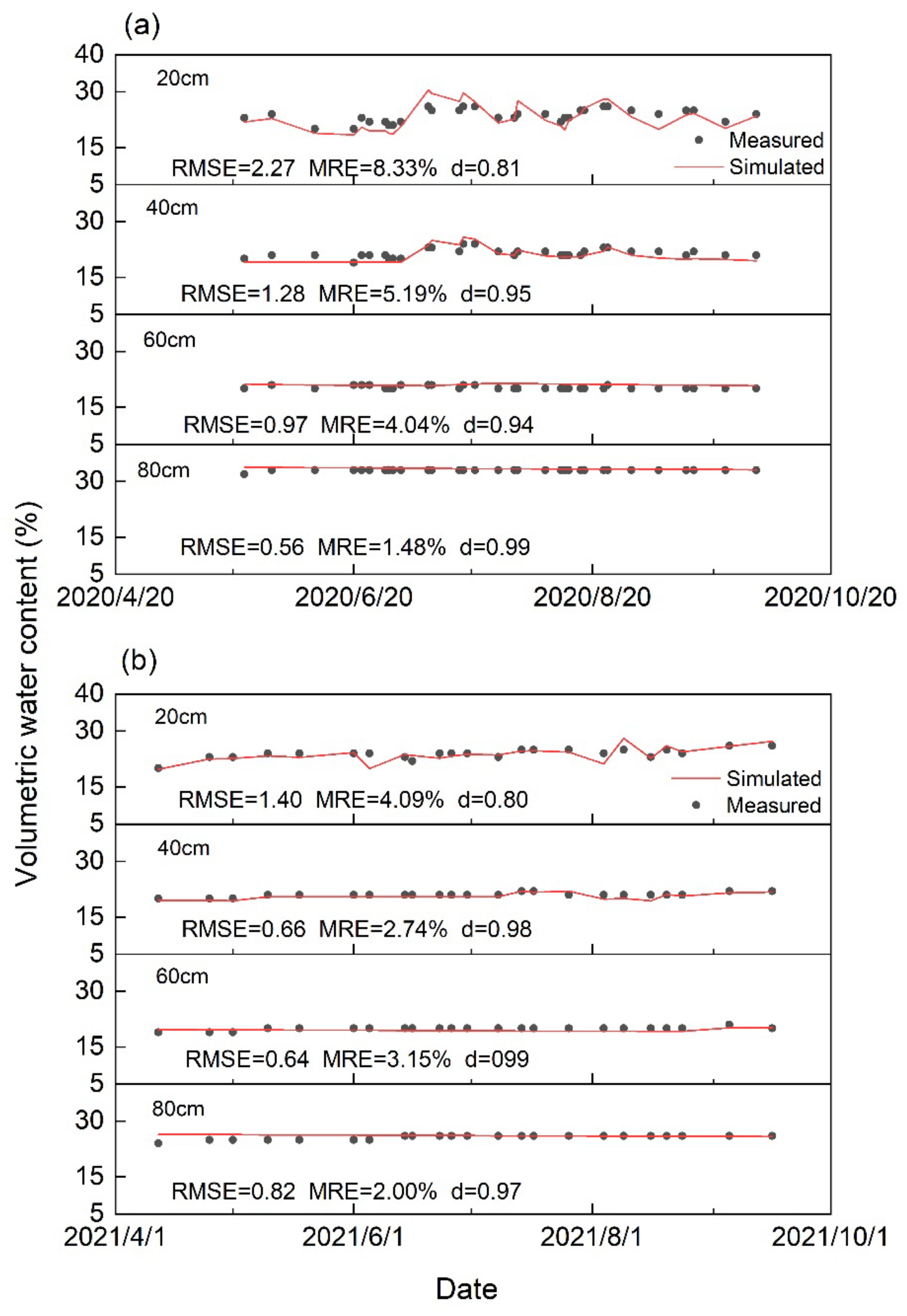

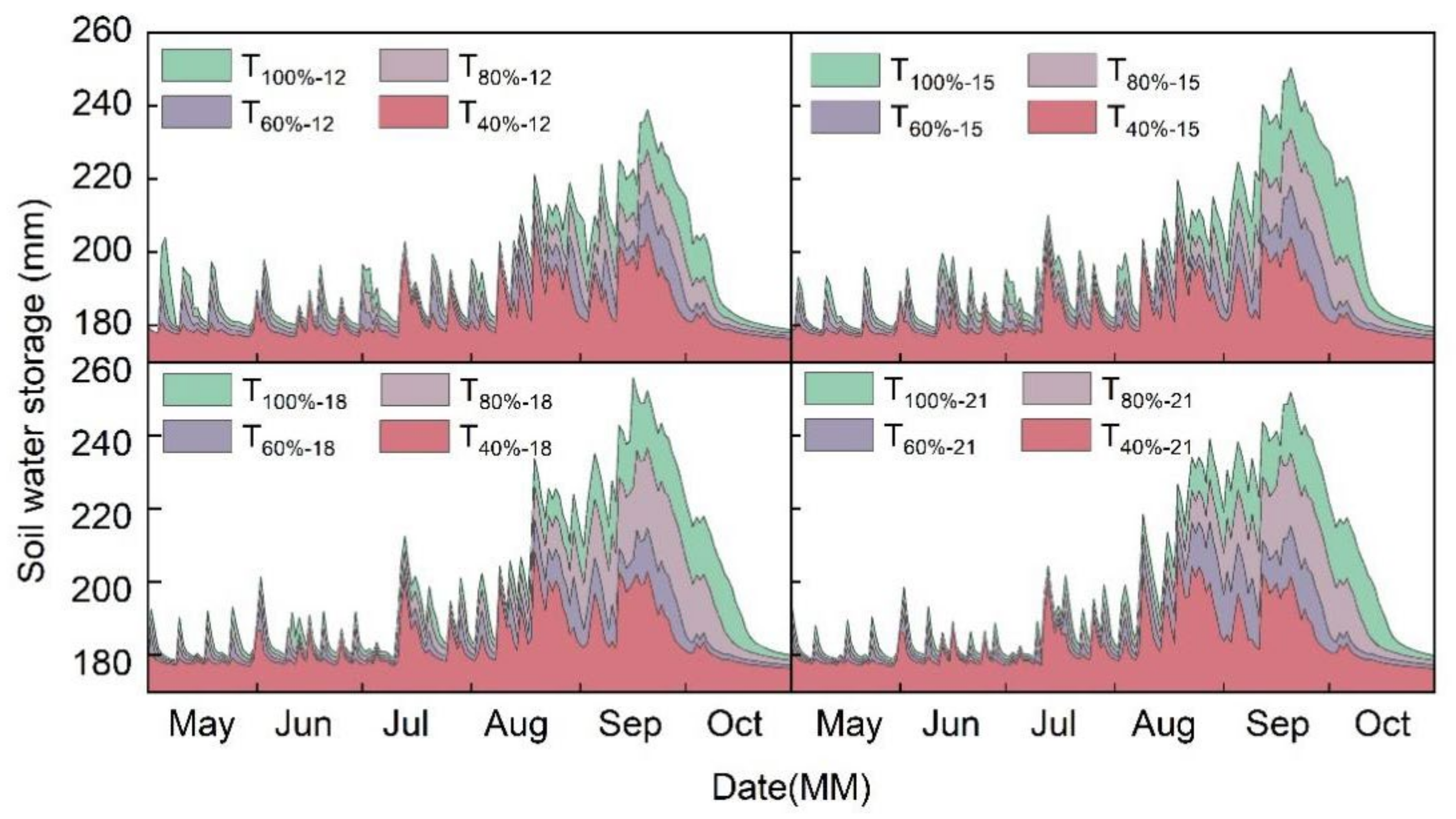
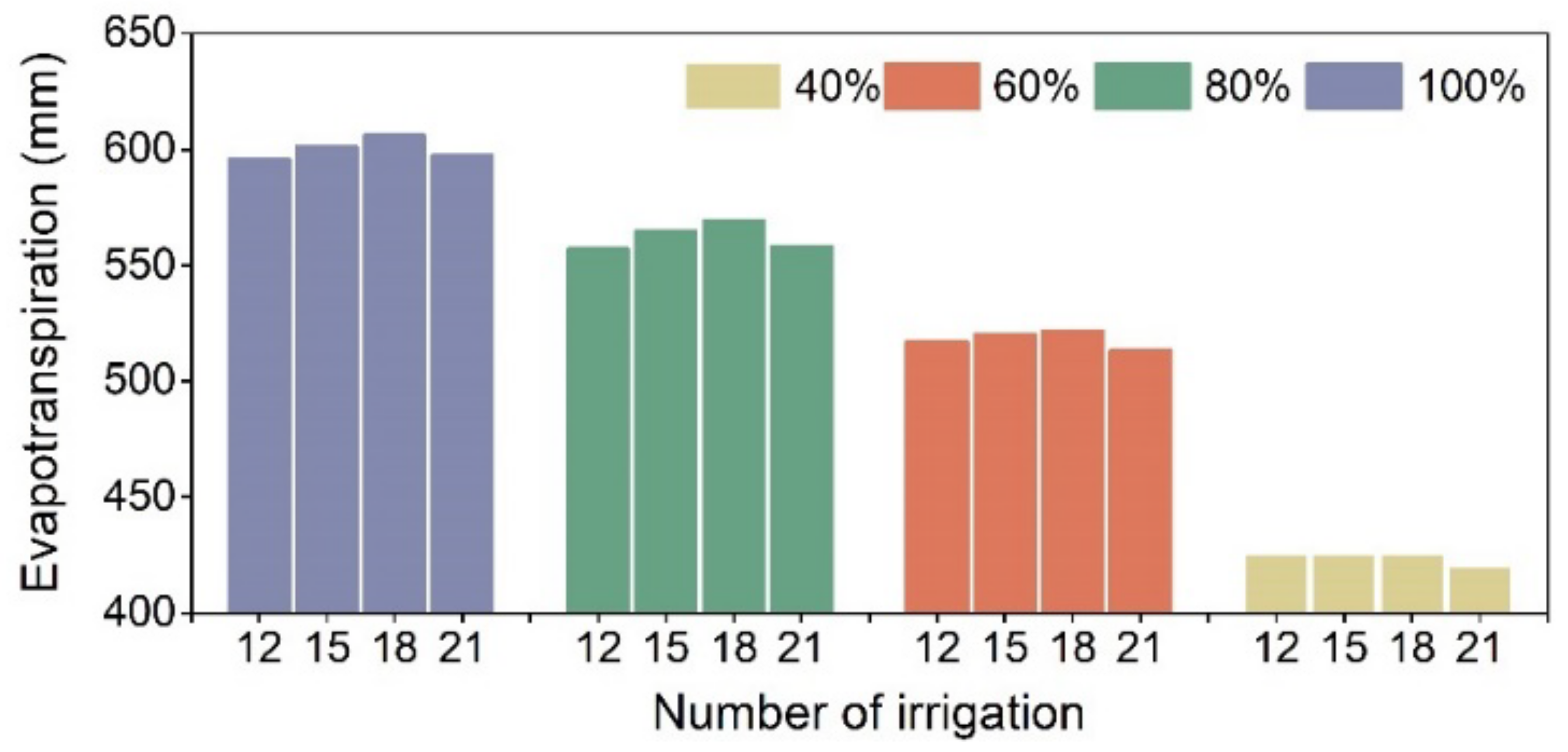
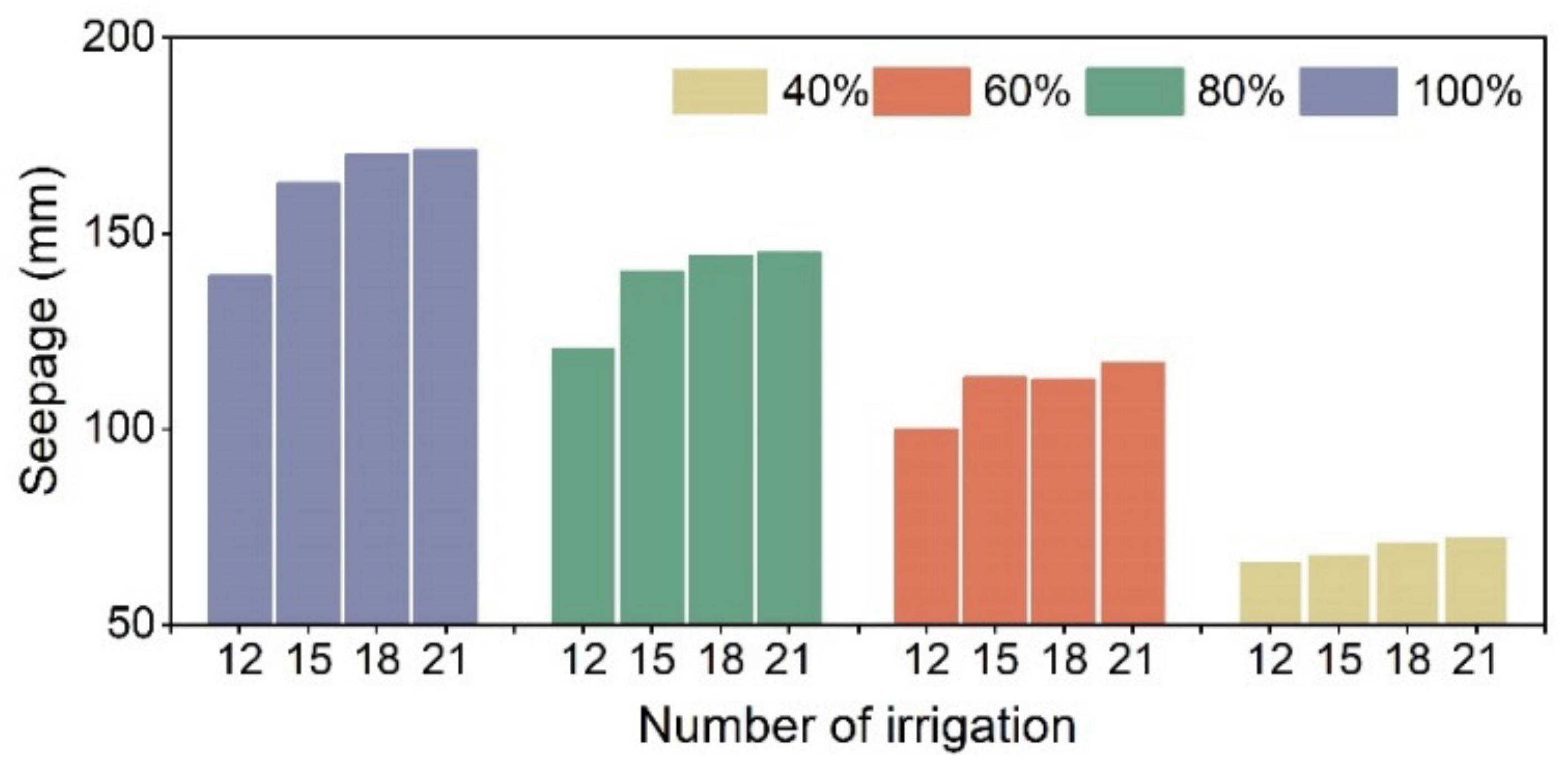
| Soil Depth (cm) | Soil Texture (%) | Bulk Density (g⋅cm−3) | Saturated Hydraulic Conductivity (cm⋅h−1) | Field Capacity Water Content (cm3⋅cm−3) | ||
|---|---|---|---|---|---|---|
| Sand | Silt | Clay | ||||
| 20 | 31.5 | 48.7 | 19.8 | 1.457 | 3.32 | 0.3435 |
| 40 | 31.2 | 47.5 | 21.3 | 1.414 | 2.16 | 0.3506 |
| 60 | 29.0 | 52.5 | 18.5 | 1.409 | 1.35 | 0.3534 |
| 80 | 20.0 | 65.0 | 15.0 | 1.322 | 0.68 | 0.3555 |
| Irrigation Scenarios | Irrigation Cap/% | Irrigation Quotas/mm | Number of Irrigations | Sub-Irrigation Volume/mm |
|---|---|---|---|---|
| T100%-12 | 100% | 355.14 | 12 | 29.60 |
| T100%-15 | 355.14 | 15 | 23.68 | |
| T100%-18 | 355.14 | 18 | 19.73 | |
| T100%-21 | 355.14 | 21 | 16.91 | |
| T80%-12 | 80% | 284.11 | 12 | 23.68 |
| T80%-15 | 284.11 | 15 | 18.94 | |
| T80%-18 | 284.11 | 18 | 15.78 | |
| T80%-21 | 284.11 | 21 | 13.53 | |
| T60%-12 | 60% | 213.08 | 12 | 17.76 |
| T60%-15 | 213.08 | 15 | 14.21 | |
| T60%-18 | 213.08 | 18 | 11.84 | |
| T60%-21 | 213.08 | 21 | 10.15 | |
| T40%-12 | 40% | 142.07 | 12 | 9.47 |
| T40%-15 | 142.07 | 15 | 7.58 | |
| T40%-18 | 142.07 | 18 | 6.31 | |
| T40%-21 | 142.07 | 21 | 5.41 |
| Irrigation Scenarios | Positive Ideal Solution Distance D+ | Negative Ideal Solution Distance D− | Relative Proximity C | Sort Result |
|---|---|---|---|---|
| T100%-12 | 1.778 | 0.257 | 0.126 | 16 |
| T100%-15 | 0.875 | 0.978 | 0.528 | 8 |
| T100%-18 | 0.770 | 1.097 | 0.588 | 7 |
| T100%-21 | 0.665 | 1.209 | 0.645 | 6 |
| T80%-12 | 0.533 | 1.303 | 0.710 | 5 |
| T80%-15 | 0.437 | 1.419 | 0.765 | 4 |
| T80%-18 | 0.343 | 1.538 | 0.818 | 3 |
| T80%-21 | 0.278 | 1.652 | 0.856 | 2 |
| T60%-12 | 0.252 | 1.768 | 0.875 | 1 |
| T60%-15 | 1.656 | 0.245 | 0.129 | 15 |
| T60%-18 | 1.540 | 0.319 | 0.172 | 14 |
| T60%-21 | 1.424 | 0.411 | 0.224 | 13 |
| T40%-12 | 1.323 | 0.566 | 0.299 | 12 |
| T40%-15 | 1.210 | 0.665 | 0.355 | 11 |
| T40%-18 | 1.096 | 0.768 | 0.412 | 10 |
| T40%-21 | 0.985 | 0.876 | 0.471 | 9 |
Disclaimer/Publisher’s Note: The statements, opinions and data contained in all publications are solely those of the individual author(s) and contributor(s) and not of MDPI and/or the editor(s). MDPI and/or the editor(s) disclaim responsibility for any injury to people or property resulting from any ideas, methods, instructions or products referred to in the content. |
© 2023 by the authors. Licensee MDPI, Basel, Switzerland. This article is an open access article distributed under the terms and conditions of the Creative Commons Attribution (CC BY) license (https://creativecommons.org/licenses/by/4.0/).
Share and Cite
Zhang, H.; Wang, J.; Liu, M.; Shen, Y.; Pei, H. Water Budget of Urban Turf Field and Optimal Irrigation Schedule Simulation in an Ecotone between Semi-Humid and Semi-Arid Regions, Northern China. Agronomy 2023, 13, 273. https://doi.org/10.3390/agronomy13010273
Zhang H, Wang J, Liu M, Shen Y, Pei H. Water Budget of Urban Turf Field and Optimal Irrigation Schedule Simulation in an Ecotone between Semi-Humid and Semi-Arid Regions, Northern China. Agronomy. 2023; 13(1):273. https://doi.org/10.3390/agronomy13010273
Chicago/Turabian StyleZhang, Hongjuan, Jianjun Wang, Mengzhu Liu, Yanjun Shen, and Hongwei Pei. 2023. "Water Budget of Urban Turf Field and Optimal Irrigation Schedule Simulation in an Ecotone between Semi-Humid and Semi-Arid Regions, Northern China" Agronomy 13, no. 1: 273. https://doi.org/10.3390/agronomy13010273
APA StyleZhang, H., Wang, J., Liu, M., Shen, Y., & Pei, H. (2023). Water Budget of Urban Turf Field and Optimal Irrigation Schedule Simulation in an Ecotone between Semi-Humid and Semi-Arid Regions, Northern China. Agronomy, 13(1), 273. https://doi.org/10.3390/agronomy13010273





